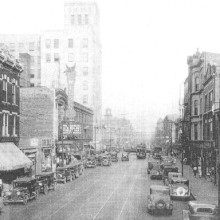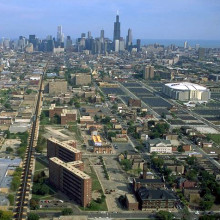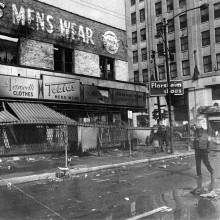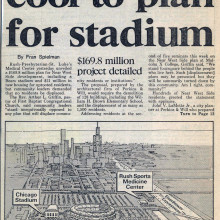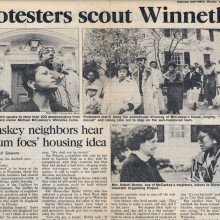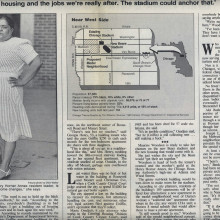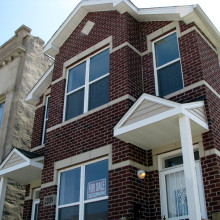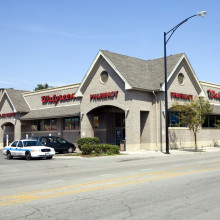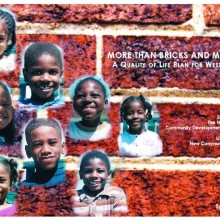This documentary explores the history of our organization and the West Haven community which it has served for over 20 years within the Near West Side of Chicago. We ask community residents, leaders and public officials how Near West Side CDC has positively impacted people’s lives.
Thanks to all of our participants:
• Jerry Reinsdorf, Chairman of the Board, Chicago Bulls & White Sox
• Howard Pizer, Executive Vice President of the United Center
• Reverend Albert D. Tyson III, Presiding Elder of AME Church
• Andrew Mooney, Commissoner, Department of Planning, Chicago
• Susana Vasquez, Executive Director, LISC Chicago
• Reverend Vance Henry, Mayoral Deputy Chief of Staff
• Alderman Walter Burnett, 27th Ward
• Willie Wright Washington, NWSCDC Board Member, West Haven Resident
• Sabrina Gates, Doctor & West Haven Community Resident
• Kahlilah Gates, Educator & West Haven Community Resident
• Dr. Harold Pates, Professor & Scholar
• Earnest Gates, Executive Director, NWSCDC
Dedicated to Wilma Ward, “The Big Six” & the Residents of West Haven. Directed and Producted by Andrew “Gravity” Kirkland of OOO Multimedium. Special thanks to LISC Chicago
Our Story:
Our 150-year-old community thrived for more than a century, with a lively central business district along Madison Street, an enviable supply of living wage jobs at the nearby Kinzie Industrial Corridor and elsewhere, and a solid, attractive housing stock with many greystones and apartment buildings.
Although never a wealthy community, our one-square mile neighborhood just west of downtown Chicago – bounded by Ashland, Talman, Van Buren and Lake Street – enjoyed a solid, working-class prosperity. But that prosperity has been interrupted for the past few decades, in the wake of two blows which less hardy folk might never have recovered.
In the late 1950s, the Chicago Housing Authority razed 12 blocks between Washington and Lake Streets to build the 1,800-unit Henry Horner Homes. The public housing project never lived up to its promise of safe and decent homes for the poor; instead, it devolved into a poorly managed community teeming with drugs and gang activity.
Then, in 1968, came the second part of the one-two punch: Riots and fires following the assassination of Dr. Martin Luther King Jr. destroyed many storefronts along Madison Street between Ashland and California. Many of the businesses that survived withered during the years that followed, and before long the stretch between Damen and Western had only four active stores. Systematic disinvestment and redlining followed, snuffing out hope of an economic rebound.
The retail flight forced us to shop elsewhere, and while some longtime homeowners continued to improve their properties, other homes suffered from the ravages of arson, scavengers and neglect by absentee landlord. This devastated the housing market and pockmarked our community with vacant lots.
the stadium campaign
But like the proverbial phoenix, West Haven – a name chosen by residents in the early 1990s, is a show of self-determination – has begun rising from the ashes. The turnaround began in 1987 when older residents organized to oppose a proposed Chicago Bears Stadium that would have resulted in the demolition of homes and displacement of about 1,500 families.
Under the leadership of the Central West Community Organization, which represented our homeowners, and the Interfaith Organizing Project, a coalition of churches, we met weekly to figure out how to stop the stadium. We knew that prior to the 1968 riots, West Haven had had a strong coalition of churches and equally strong schools, among many other assets, and we were determined to rebuild our neighborhood our way.
Among our more creative and dramatic tactics in this gridiron showdown was the well-attended flag football game that we played on the street in front of the home of Bears owner Michael McCaskey, in leafy north-suburban Winnetka. Neighbors got a taste of the siege our neighborhood would have been faced with on game day – and when one lady complained that she couldn’t get out of her garage, the Winnetka police correctly answered: “That’s their point. That’s why they’re here.”
The Rev. Albert D. Tyson III, pastor of St. Stephens AME Church since 1985 and an Interfaith Organizing Project member, recently reminded our older residents and schooled our newer residents about all that. Unimpressed by the Bears’ vague oral promises to replace the housing of those displaced, he said, “The community rose up and said, ‘No, you’re not going to do that.’” The Bears management “Never consulted with those who lived, worked and worshiped in the community.”
Instead, we put forth “The Better Alternative,” a development plan of our own (published 1987) that focused on building affordable housing and creating new resources like a library, park and community center for youth. That organizing process not only sacked the Bears proposal but, a few years later, helped the community achieve many of its goals when the Chicago Bulls wanted to build what later became the United Center in the early 1990s.
Using “The Better Alternative” as our playbook, we worked with the stadium’s owners and the city to build replacement housing for those displaced by the United Center, set aside other land for affordable housing, added onto the existing Touhy Herbert Park, and build both the Mable Manning public library (named after a neighborhood leader) and the James Jordan Boys & Girls Club and Family Life Center.
“The beauty of everything that previously occurred is that the people all managed to come together,” the Rev. Tyson said recently, during a meeting of our quality-of-life planning process task force. “Now you have an opportunity again to shape what this community will look like.”
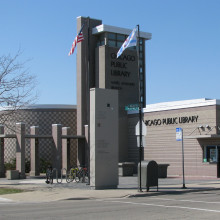
Our library built in the 1990s, as part of “The Better Alternative” plan and named after a community hero.
neighborhood revival
The Near West Side CDC, Founded in 1988, continues to lead our neighborhood’s revival efforts. Near West meets with residents, churches, other community groups and government officials to put ideas on the table and advocate policies that will improve West Haven for the benefit of all.
Near West CDC implements managed development aimed primarily at our existing residents. Its strategy – one that the community has adopted as its own – recognizes that gentrification is coming given our prime location west of the Loop. We are determined, however, that neighborhood’s revival should continue to find a place for – and not displace – those who have weathered lean years.
Our neighborhood has enjoyed numerous encouraging signs during the past decade. The two-part redevelopment of Henry Horner Homes – a piece of the Chicago Housing Authority’s “Transformation Plan” that’s been named West Haven Park – has resulted in the 200-unit Villages of West Haven, low-rise red brick townhouses; and a 544-unit, mixed-income project that blends public housing apartments, affordable for-sale homes and rental, and market-rate units. The redevelopment of Rockwell Gardens to the west, into the 750-unit, mixed income West End community, with 500 units on site and 250 nearby, has extended our geographic focus west of Western Avenue.
This new housing has been completed with affordable housing developed by Near West Side CDC, which has built 70 single-family and two-flat units through the New Homes for Chicago program and co-developed 150 scattered units of replacement housing for Horner. More recently, market rate developers have built two 34-unit condominium projects, one on Adams east of Western and another at Madison and Leavitt, and several similar projects are on the way.
The retail sector has begun to revive as well. A new bank branch, dental office and Walgreen store have opened on Madison Street, co-developed by Near West Side CDC, and we look forward to the opening of the Shopping Center Western Avenue anchored by a full-service grocery store. The 52,000 square foot development will create dozens of new jobs and is expected to contain 5 smaller businesses.
Near West has also taken the lead on social service projects, such as creating childcare connections. The Home Repairs for Accessible and Independent Living program provides accessible ramps to our seniors so they can stay in their homes. The Home Visitors Program, the city’s first “Service connector” model, has helped hundreds of our public housing tenants make the transition to mixed-income developments.
In 2006, Near West opened a Center for Working Families, co-located with the Home Visitors Program, part of a citywide effort that bundles tax preparation, public benefits screening, job placement and training, and professional financial planning to help people lift themselves out of poverty. In 2007, our site assisted 533 taxpayers file for $835,468 in federal tax returns and Earned Income Credits.
We enjoy close proximity to major transportation arteries including the Eisenhower Express way, Western Avenue, and the CTA’s Green, Pink and Blue lines. We have three parks, eight local schools and Malcolm X College, not to mention the proverbial “House the Jordan” – the United Center.
Second round of planning
Our community first participated in LISC’s quality-of-life planning process during its pilot New Communities Initiative in 2001-02. Along with Pilsen and South Chicago, we helped LISC test a more comprehensive approach to community development, which started by convening various stakeholders – residents, businesses, political leaders social service agencies – to brainstorm, strategize and ultimately implement projects.
Near West Side CDC served as lead agency for that seven month process, involving more than 100 residents in creation of a plan for our neighborhood – because, in the words of longtime community activist Wilma Ward, “If we don’t, someone else will.”
We took home maps of the community and drew in our own ideas, where developers might have wanted high-priced housing and high-end retail. “We have to think about balance,” said Michael Cunningham, a homeowner. “What do we want the neighborhood to look like and feel like?”
Among the more ambitious goals stated in that vision was this one: “Old dividing lines will blur as long-time residents and newcomers rebuild connections.” That goal has become even more pertinent five years later, when many of the same people – along with a smattering of new folks – reconvened to update the previous plan. Among other drivers, the CHA’s Plan for Transformation had begun creating new communities where people of different socioeconomic classes and ethnicities mixed in close proximity. Here was a clip from Near West during that time period:
Until this point of the “Our Story” website page, you have been reading an excerpt from our most recently published community plan, “West Haven: Rising Like the Phoenix”. Published in 2008, you can download a copy here. To learn more about our organization and what we’re presently up to (from 2005 to current), please view our West Haven Now page (under construction)

